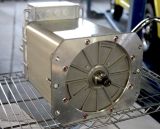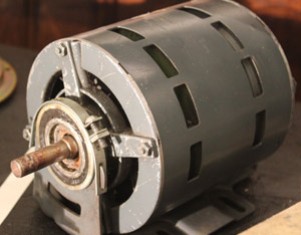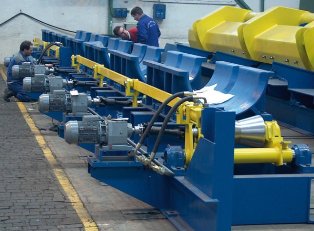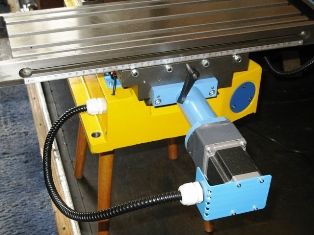What is an electric drive?
 Each machine consists of three main parts: the engine, the transmission mechanism to the executive body. In order for a technological machine to perform its functions, its executive organs must perform very specific movements, which are carried out with the help of a drive.
Each machine consists of three main parts: the engine, the transmission mechanism to the executive body. In order for a technological machine to perform its functions, its executive organs must perform very specific movements, which are carried out with the help of a drive.
In general, propulsion can be manual, horse-drawn, mechanical, as well as by a wind turbine, water wheel, steam or gas turbine, internal combustion engine, pneumatic, hydraulic or electric motor. The drive is the main structural element of any technological machine, its main task is to provide the necessary movement of the executive body of the machine according to a given law. A modern technological machine can be represented as a complex of interacting drives united by a control system that provides executive bodies with the necessary movements along complex trajectories.
In the process of development of industrial production, the electric drive took the first place in industry and in everyday life in terms of the number and total installed power of motors. In any electric drive, it is possible to distinguish a power section, through which the energy is transmitted from the engine to the executive body, and a control system that ensures its necessary movement according to a given law.
As technology has evolved, the definition of electric drive has been refined and expanded both in the direction of mechanics and in the direction of control systems. In the book "Application of Electric Motors in Industry", published in 1935, Professor of the Leningrad Industrial Institute V.K. Popov gave the following definition of a controlled electric drive: "We call a controlled motor and drive one that can change the speed regardless from loading. »

Expanding the areas of application and functions of electric drives in the complex automation of production processes requires clarification and expansion of the concept of "electric drive". At the 3rd Conference on Automation of Manufacturing Processes in Machine Building and Automated Electric Drive in Industry, held in Moscow in May 1959, the following definition was used: «An electric drive is a complex device that converts electrical energy into mechanical energy and provides electrical control of the converted mechanical energy.»
In 1960, S.I.Artobolevsky in his work "The drive - the main structural element of the machine" concluded that the study of drives as complex systems, including the engine, the transmission mechanism and the drive mechanism, is not given the necessary attention. Electric drive theory studies the operating conditions of an electric motor without considering the transmission mechanism and auxiliary body, and theoretical mechanics studies the transmission devices and executive organs without considering the influence of the motor.
In 1974, in the textbook "Fundamentals of automated electric drive" Chilikina M.G. and other authors, the following definition was given: "An electric drive is an electromechanical device designed for electrification and automation of industrial processes, consisting of a converter, an electric motor, a device for transmission and management.'
From the transmission device, the mechanical energy is transmitted directly to the executive or working body of the production mechanism. The electric drive converts electrical energy into mechanical energy and provides electrical control of the converted energy in accordance with the technological requirements for the operating modes of the production mechanism.

In 1977, in the polytechnic dictionary, published under the editorship of Academician I.I. Artobolevsky, the following definition was given: «The electric drive is an electromechanical device for driving mechanisms and machines, in which the electric motor serves as a source of mechanical energy. An electric drive consists of one or more electric motors, a transmission mechanism and control equipment. »
Modern electric drives are characterized by a high degree of automation, which allows them to work in the most economical modes and to reproduce with high accuracy the necessary parameters of the movement of the executive body of the machine. Therefore, in the early 1990s, the electric drive concept will be extended to the field of automation.
In GOST R50369-92 «Electric drives. Terms and definitions» the following definition is given: «Electric drive is an electromechanical system consisting of the general case of interacting electrical energy converters, electromechanical and mechanical converters, control and information devices and devices for connection to external electrical, mechanical, control and information systems designed to set in motion the executive bodies of the working machine and to control this motion in order to implement the technological process. »
In the textbook of V.I. Klyuchev "Theory of electric drive", published in 2001, the following definition of electric drive as a technical device is given: "An electric drive is an electromechanical device designed to drive the working organs of machines and control technological processes, consisting of a transmission device , a device with an electric motor and a control device «… In this case, the following explanations are given for the purpose and composition of the various parts of the electric drive.
The transmission assembly contains mechanical transmissions to the clutches, which are necessary to transmit the mechanical energy generated by the engine to the drive.
The converter is designed to control the flow of electrical energy coming from the network to regulate the operating modes of the motor and mechanism. This is the power part of the electric drive control system.
The control device is an informational low-current part of the control system, designed to collect and process the input information about the influences of the setting, the state of the system and the generation based on it of control signals for the conversion of electromotor devices.
In general, the concept of «electric drive» can have two interpretations: electric drive as a collection of various devices and electric drive as a branch of science. In the university textbook "Theory of Automated Electric Drive", published in 1979, it is noted that "the theory of electric drive as an independent science was born in our country." The beginning of its origin can be considered 1880, when the magazine "Electricity" published an article by D. A. Lachinov "Electromechanical work", in which the advantages of the electrical distribution of mechanical energy were substantiated for the first time.
In the same textbook, the concept of electric drive is given as a section of applied science: "The theory of electric drive is a technical science that studies the general properties of electromechanical systems, the laws governing their movement and the methods of synthesizing such systems according to the given indicators. »
Currently, electric drive is an important, rapidly developing field of science and technology, which occupies a leading place in the electrification and automation of industry and everyday life, the direction of its development is determined by the expansion of application areas and increased requirements for electrical systems and complexes.
Electric propulsion is the energy basis for the industrialization of technological processes in industrial production. The pace of his performance is high. The electric drive consumes more than 60% of the total electricity.
The improvement of electric drives is currently carried out in the direction of increasing their productivity, reliability, efficiency, accuracy of work, reducing the specific weight and size indicators of individual devices and electromechanical systems as a whole. At all stages of the improvement of electrical engineering, the achievement of the necessary indicators by electric drive was accompanied by the development of its theoretical foundations.

